Cliffe Park Cottage
In 1774 Thomas Hindle was granted a lease on a tenement and land in Great Harwood, named as Ryley’s Tenement of the Bowleys and a croft. It was a renewal of a lease made in 1717, which may have been a renewal of an earlier lease on the land. The Bowleys are the fields around Bowley Hill west of Dean Lane, while the croft was, and is, situated at Cliffe and is now known as Cliffe Park Cottage.
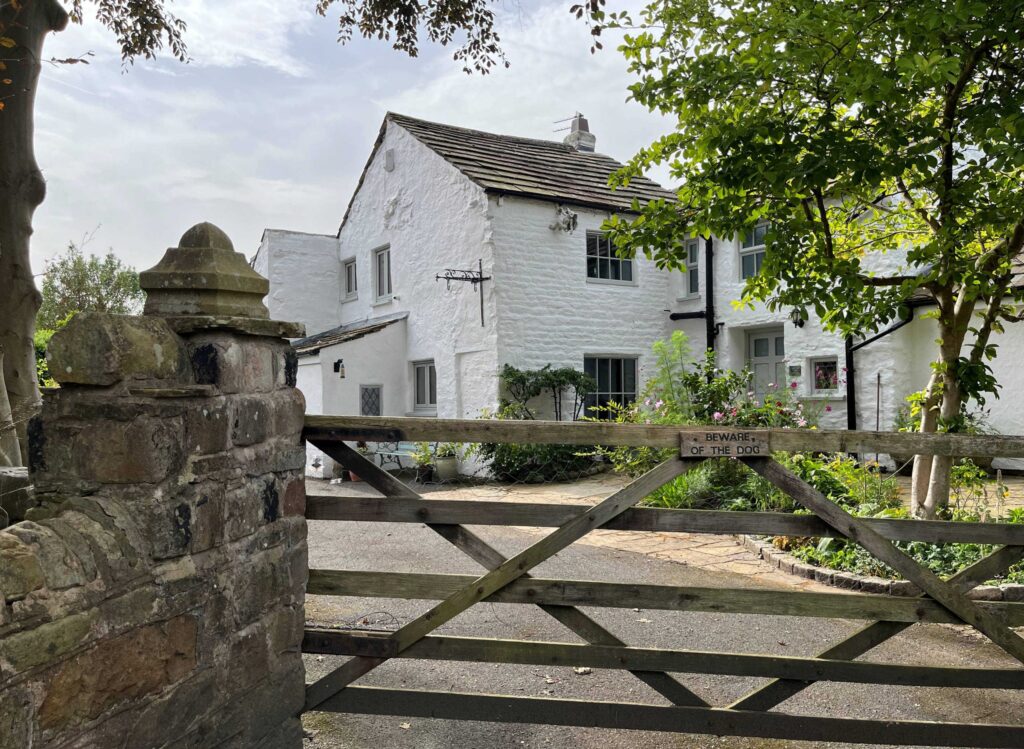
Cliffe Park Cottage lies to the west of Cliffe Lane in Great Harwood, across the road from the Dog and Otter public house. To the west and south of the house there are bungalows built in the twentieth century, to the north another old house. The history of the Dog and Otter and the old house to the north are both associated with the history of Ryley’s Tenement.
The house has been altered in many ways over the years – parts taken away and parts added – but is probably of eighteenth-century origin, or possibly seventeenth century. It would need detailed analysis by an expert in vernacular architecture, and perhaps a dendrochronologist to determine a more exact date. To trace the history of the owners and occupiers of the house manorial records, maps, parish records, census returns and conveyancing documents have been used – but there are very few records for the town before the start of the eighteenth century.

Ryley’s Tenement of 6 acres 2 roods and 37 perches was granted to Thomas Hindle in 1717. When Thomas Hesketh died in 1735 a survey was made of the lands he owned in Great Harwood. He was Lord of the Manor of two thirds of the town, chiefly the Upper Town where the area known as Cliff was situated and these are the lands recorded as leased to Thomas Hindle:
Scite Croft Barn and Gardens
Bowleys
House Barn Garden and two crofts
Great Meadow
Field next Lane
Stoops meadow
Field below barn
Barn Field
Total area 17 acres 1 rood 14 perches.
Thomas Hindle was leasing not only land at Cliffe, but also at what is now called Heymoor. We know this because a map made around 1763 gives most of the fields in Great Harwood and their names and can be cross referenced with lease registers. In the above list of fields Bowleys is part of Ryley’s tenement, but it isn’t clear whether the first entry (Croft, barn, and gardens) or the third (House, barn, garden and two crofts) relates to Ryley’s, so we can’t know whether there was a house there when the lease was taken out, or whether buildings other than a barn were added later.
At this time lands were often let for a term of lives, although many farms remained in the same family for generations in Great Harwood. This lease had been granted to Thomas Hindle with his sons William Hindle aged 20, and Thomas Hindle aged 18 named as the lives on the lease. Thomas Hindle, married Mary Hargreaves of Oswaldtwistle at Church Kirk in 1710. The lease was renewed in 1774 and the lessee at that time was the son of the William Hindle named on the lease of 1717, Thomas Hindle, with his uncle Thomas Hindle and John Smalley the other lives named on the lease. Although the Hindles and their descendants were the leaseholders of the tenement under Hesketh until the early nineteenth century they did not live there and were subletting the land and buildings from at least the mid eighteenth century. It has been quite easy to trace the owners and main tenants of Cliffe Park Cottage, but working out who lived there has been challenging.
In the seventeenth century, and for most of the following century, Great Harwood was a town of two parts. The lower town (which mostly lies to the south of the Nap Brook which runs from Lowerfold to the Hyndburn) was held by the Nowells of Read. Most of the upper town was in the hands of the Heskeths of Rufford, and the Heskeths were the owners of the land where Cliffe Cottage stands until they sold the whole of their lands in Great Harwood and Tottleworth to Richard Grimshaw Lomax of Clayton Hall in 1819. The Lomax family (and later Trappes-Lomax) added to their lands over the course of the nineteenth century but began to sell parts in the early years of the twentieth century.
Maps are a wonderful resource for local history. For Great Harwood the first map that shows buildings that can be identified as Ryley’s Tenement is one that is held by a descendent of the Trappes-Lomax family. It is a copy of a map made in 1763 to show all the fields of Great Harwood with their names. ‘Bowleys’ is shown and a long building on a croft in the area now known as Cliffe Park.
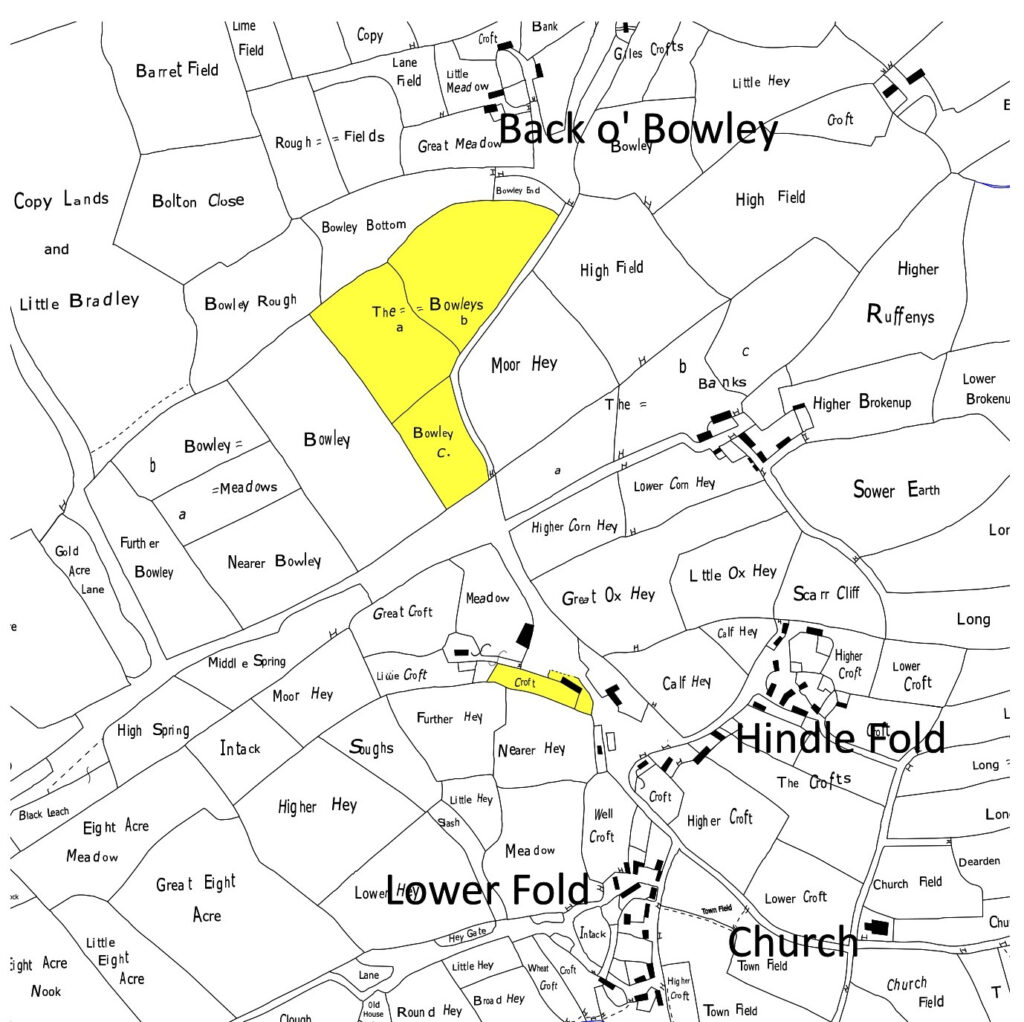
The first Ordnance Survey map of the town, surveyed in 1844 shows is a long range of buildings marked ‘Smithy’. Text on maps is not always accurately linked to the place it describes; in this case however it does seem clear which buildings are indicated to be the smithy.
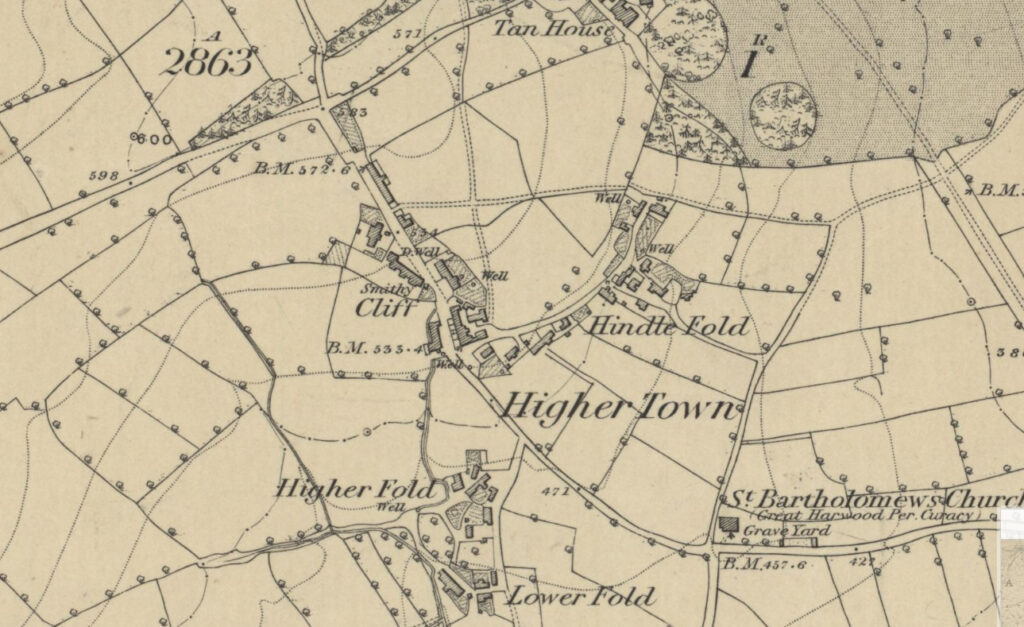
Reproduced with the permission of the National Library of Scotland
If Hesketh, and later the Lomax families, were the owners of the land at Ryley’s Tenement, and if the Hindles were the tenants but did not live there, who then were the occupiers? There are two good clues to follow to attempt to answer that question:
- The tenement was called Ryley’s and farms and tenements were often named after the people who lived there.
- The buildings were marked as a smithy in 1844 – could the presence of a smith be traced in the area?
The parish register of Saint Bartholomew’s Parish Church in Great Harwood lists a marriage that took place on 27 December 1693 as follows:
John Riley – Blacksmith, Upper Town and Grace Blore – Widow, Upper Town were married by Banns being published 3 times at Harwood.
It is possible that Grace was the widow of George Blore who died in 1691 in the Upper Town. George was the son of William Blore, also of Upper Town and himself a blacksmith. Grace’s burial is noted in the parish register in 1724 as the wife of John Riley, Farrier, but by now they are living in the lower town. It seems probable that they were the tenants until 1717 when William Hindle took the lease, but their name then lingered on for many years.
The Hindles main habitation was at Lower Edge End, which later became Dobson’s Farm. A lease was made to William Hindle, innkeeper, for the property in 1720. It is clear that William Hindle was not a blacksmith so may have needed to find a suitable tenant for Ryley’s. Records show that a Thomas Critchlow or Critchley, a blacksmith, moved to the town from Padiham sometime between 1725 and 1727 when his son Richard was baptised at Great Harwood church. Births and deaths for the children of Thomas Critchlow, smith, are recorded at Cliff until 1732. Thomas’s wife Ann was buried the day their daughter Ann was baptised on the 22 April 1734, but by this time Thomas is living in the Lower Town. After that year there is no mention in the parish register of a smith or blacksmith living at Cliff until 1753; all smiths are shown as being at Lower Town. This may simply mean that if there was a smith working at Cliffe there were no significant life events to be recorded for him or his family.
In 1753 the parish register of Great Harwood church recorded that John and James, sons of John Haworth of Cliff, Blacksmith, were baptised. This family were associated with the smithy and other buildings at Cliff for over one hundred years. The will of John Haworth, made in 1797 but not proved until 1814, is the first probate document we know that relates to a family living at the Cliffe Park Cottage.
It isn’t possible to be certain of the age of John Haworth when he died, so it isn’t possible to say when he was born, but we do know he was not born in Great Harwood. Settlement records for Great Harwood show that John and his wife Mary applied for leave to settle in the town from Filly Close in Reedley Hallows near Burnley. In the settlement certificate his children were named as Mary, Alice, John, James and George. The first two children were baptised in Haslingden, the remainder in Great Harwood so it seems that the permission to settle was somewhat retrospective and that John had not lived in Reedley Hallows for some time; he may have been born there or he may have gained legal settlement in Reedley Hallows because of an apprenticeship. Mary Haworth, wife of John Howarth of Cliffe, blacksmith, was buried in February 1758, shortly after the burial of her son William on the 27 January that year. John remarried, probably to Jane Greenwood of Livesey, in 1759 and she died at Cliff in 1814 age 84. John Haworth named his living children in his will of 1797 as James, John, Ann, George, Henry, Isaac, William, Alice (wife of Ellis Nutter) and Jenny (wife of James Taylor).
In his will John Haworth states that he held his tenement at Higher Cliff by lease under Hesketh. However, this was not the smithy building and cottages, but a messuage just across the road, the building shown on both the 1763 and 1796 plans. A lease for the property exists from 1758, and one document states that John Haworth was admitted to the tenement, but it isn’t clear when. At least two of his sons followed their father into the blacksmith’s trade, John and Henry and in his will he left all his smithy tools stood in the smithy to Henry. We know that his son John was also a blacksmith as he was named as such in the will; other records show that Isaac was also a smith. Although John Haworth made his will in 1797, he did not die until either 1807 or 1811. There is a burial that may be for him for 1807 but none for 1811, however the probate notes state he died in 1811, which may have been an error. Probate was not granted until after the death of his wife Jane in 1814.
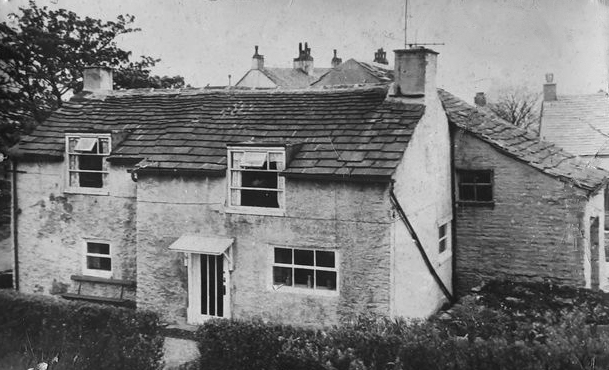
Henry Haworth, son of John, was born in 1762 and it appears he remained as a blacksmith at Cliff all his adult life. He married Ann Dugdale in 1789 and like his father had a large family with his son Jonathan following him into the blacksmith’s trade as he had followed his father. Henry died in 1843, just two years after his son Jonathan had married Elizabeth Mercer. No children were born to John and Elizabeth and after the death of Elizabeth in 1858 Jonathan lived with the children of his sister Alice. Alice had married Thomas Taylor, but she died in 1844 and Thomas married again. Jonathan was last recorded at Cliff as a blacksmith in the 1861 census. He died in 1876, not at Cliff but at Birtwistle Terrace which must have been newly built then. The cottage at Cliff was noted in rentals in 1873 as no longer being a smithy.
The Lomax family of Clayton le Moors had first bought Nowell lands in the 1770s and then most of the Hesketh estate in 1819, and from this time there are rent ledgers for farms and cottages in the town. The ledgers show that Francis Hodgkinson took over the buildings associated with the smithy from 1876 to 1878. Then there is a gap until 1881 when James Gorton was leasing the building until 1883. A James Gorton, blacksmith lived in Blackburn, and he had a son James who was a blacksmith. There is no record of either man living or working at the address, but it is possible a tenancy was taken as a business opportunity, possibly for the son who would be about 25 in this year. There is no evidence that the building was used as a smithy after 1873 though, as noted in the rentals for that year.
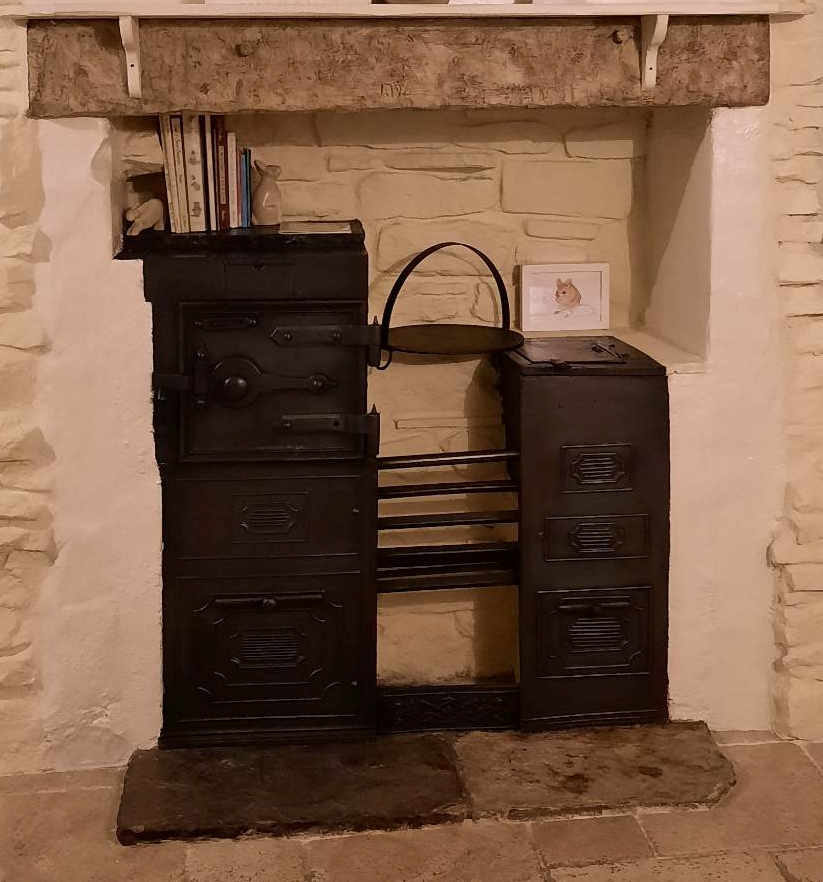
It would be in the time of either Henry or his son Jonathan that the still existing cast iron range would be installed in number 15, now Cliffe Park Cottage. Made by ‘Tempest of Blackburn’ a firm that was in operation from before 1841 up until sometime after 1851, being shown at Blackburn in the census returns for those years. By 1861 John Tempest had moved to Liverpool so the range was certainly installed before this time.
The numbering of the houses has been a major problem in deciding as to which places records and documents refer. Using all available documentary evidence and maps it seems that the smithy and associated buildings were represented in most census years as numbers 7, 11, 13 and 15. What is now 15 Cliffe Park appears to comprise what were the original numbers 13 and 15, and what had been the smithy, number 7, being demolished sometime between 1912 and 1929 and number 11 around 1921.
The table below shows the names of the heads of households resident in the four buildings at Cliff Park (although it wasn’t known as such at the time):
| No 7 (Smithy) | No 11 | No 13 | No 15 | |
| 1841 (no numbers) | Henry Haworth | James Walmsley | Ellen Mercer | Sarah McIntosh |
| 1851 | Jonathan Haworth | Charles Wolstenholme | John Smith | James Birtwistle |
| 1861 | Jonathan Haworth | Joseph Hindle | John Smith (with Charles Wolstenholme, son in law, and family) | James Birtwistle |
| 1871 | Jonathan Haworth | William Baron | Charles Wolstenholme | James Birtwistle |
| 1881 | William Baron | Edward Kemp | John Clayton | James Birtwistle |
| 1891 | Not listed | Anthony Quinn | James Rostron | William Swales |
| 1901 | Not listed | William J Shaw | Elizabeth Clayton | David Waterhouse |
| 1911 | Not listed | William J Shaw | Alice Middlehurst | Nathaniel Faud |
| 1921 | Not listed | Not listed | Not listed | Richard Dobson |
| 1939 | Not listed | Not listed | ? N Haworth | John W Lane |
It is often thought that Cliffe Park Cottage was the childhood home of the wife of John Mercer the Chemist, whose maiden name was Mary Wolstenholme. In his unpublished autobiography he states that:
I had known the 2 Wolstenholme lasses some time through meeting at places of worship with them, so I began courting Mary the younger of the two and married her, we stayed at the farm only a year or two, then I left and went a little lower to the old inn.
The old inn was the Grey Horse, or as it was at times known, the Old Billy and which stood opposite the entrance to Hindle Fold Lane. This means that the farm he was talking about was higher up the road, which could be either the dwellings at Cliff park or the houses to the north, now numbered 17 and 19. Although a Charles Wolstenholme did live at numbers 11 and 13 for a time, as shown in the table above, he was a very distant relative of Mary Wolstenholme wife of John Mercer, and land records show that James Wolstenholme, father of Mary, was tenant of the farm to the north, now 17 and 19 Cliffe Park – formerly known as Dobson’s or Aspden’s Tenement.
On the table of heads of household all those listed for numbers 13 and 15 can be said to be previous tenants of Cliffe Park Cottage as the two were made into one sometime after 1920 when the house was sold by the Trappes-Lomax family.
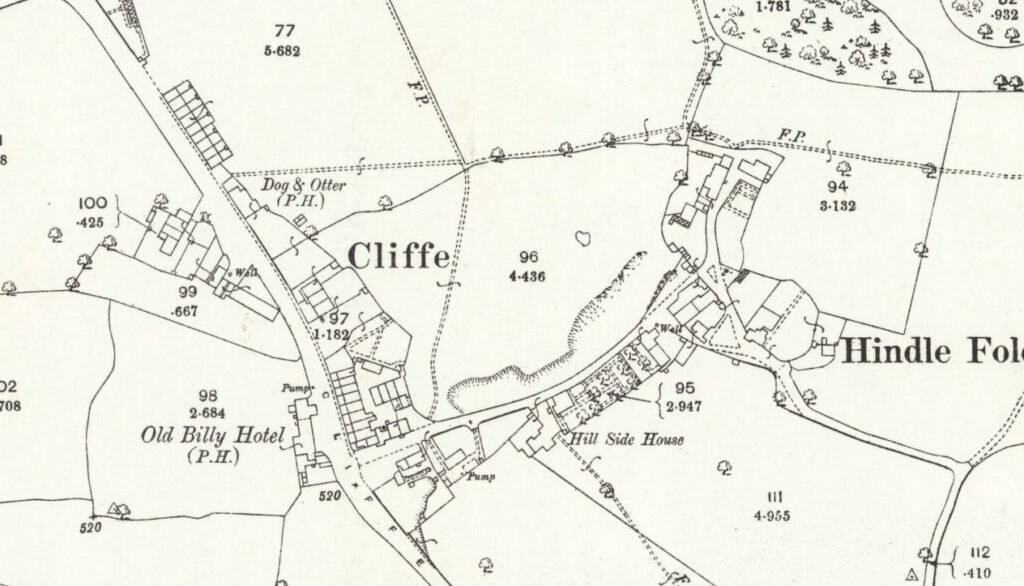
Reproduced with the permission of the National Library of Scotland
The Ordnance Survey map surveyed in 1890 shows the original layout of the four dwellings, as does the map surveyed in 1909 and it seems that number 7, the former smithy, was abandoned as a dwelling house sometime after 1881. The next Ordnance Survey map was a revision in 1929 and by then all of what was the smithy block had gone, leaving three buildings. However, the above table suggests that only the two cottages that became 15 Cliffe Park were inhabited in 1921. This was the time that the houses were bought by a man called John Washington Baron and his partner William Pickup.
John Washington Baron was the son of David Baron and his wife Sarah, who became grocers and confectioners. At the census of 1881, aged fourteen, John is described as a newsboy, but it is unclear exactly what this entailed. Most sources suggest pauper children selling newspapers on the street but that doesn’t seem to apply to John Washington Baron. His formal education had finished but he must have been a clever young man as at the age of nineteen he was nominated to become the auditor of the Industrial Co-operative Provision Society and ousted David Bentley from the role that he had undertaken for twelve years. Mike Rothwell, in his book The Industrial Heritage of Great Harwood, says that John W Baron was the secretary of Wellington Mill in 1882 when he would have been only sixteen. Wellington Mill was started by Robert Smith and in 1882 was taken over by Charles and Nathan Smith, his sons. In 1888 John Washington Baron married Ellen Smith, daughter of Wilson Smith who was the cousin of Charles and Nathan. The 1891 census shows that he and Ellen were living in Cheetham, Manchester and at that time he was an assistant editor and author. Rothwell found that at the time he worked for the Manchester Textile Journal.
The family returned to Great Harwood and by the census of 1901 were living at 20 South View in the town with John now a salesman for cotton goods, although directory entries from 1894 onwards describe him as a mill manager. In 1911 the family were at The Cedars, a large, detached house on Cliffe Lane, and he was now a partner in the firm Boardman and Baron. They owned three weaving sheds in Great Harwood, one in Rishton and another in Clayton le Moors.
Great Harwood Urban District Council valuation book for 1921 lists John Washington Baron as both the owner and occupier of the property at Cliffe Park but he was still living at the Cedars and the 1921 census shows that a Richard Dobson was the occupier. As the table above shows, only number 15 is listed in that census and from then on but with one exception. A directory published in 1939 lists a Mrs N M Howarth as being at number 15, with nobody listed for 11 and 13. The directory may have been compiled more than a year before publication. We do know that the 1939 Register was taken on 29 September 1939 and on that date at 13 Cliffe Park is a retired widow born on 10 November 1862, named Howarth, first name illegible, second initial N. It hasn’t been possible, so far, to identify who this individual may be. Listed at 15 Cliffe Park is John W Lane.
John William Lane married Mary Ada Baron in 1900 – and Mary Ada was the sister of John Washington Baron. John William and Mary Ada were living in Blackpool on the 1921 census, when John’s occupation is given as Yarn Agent at Manchester Exchange. Directories and the 1939 Register show that John and Mary Ada Lane moved to Cliffe Cottage in 1938 or 1939. When Mary Ada died in August that year her address was recorded as 15 Cliffe Park. John William Lane himself died in 1950, with his address given as 15 Cliff – he lived there until he died despite two changes of ownership in that time.
John Washington Baron died in 1943 and probate was granted to his daughter Sarah Baron and son Henry Lewis Baron. The following year Cliff Park Cottage was sold to Sarah Elizabeth Woof. She only retained ownership of the building for a few years selling the property on in 1949. Born Sarah Elizabeth Hartley in 1898 at Clitheroe, she married William James Woof at St. Bartholomew’s church in Great Harwood in 1938. William Woof seems to have been a very successful and skilled building contractor; he was chosen to work on the restoration of Crossrigg Hall, Westmorland in 1914. It is tempting to speculate whether he may have been involved in changes made to the building. However, Sarah sold the house to Robert and Elizabeth Ellen Vickery in 1948, farmers from Back o’Bowley.
That there was a smithy at Cliff before 1700 is certain; whether the current buildings date from that time is yet to be proved, although the mullion window remaining on Cliffe Park Cottage suggests this. There are no photographs of the demolished parts of the building, those which contained the smithy and the cottage attached to it, so there is no way to know how old that part of the tenement may have been. The house, which may at one time have become several old, run down cottages, is now a very desirable residence – with a long and interesting history.
SOURCES
Documentary Sources
Parish registers accessed via Ancestry.co.uk
Census records accessed via Ancestry.co.uk and Find My Past (1921)
1939 register accessed via Ancestry.co.uk
Probate documents:
Accessed via Family Search. Original records at Lancashire Archives.
William Blore of Great Harwood Admon with Inv 1681 Supra
https://www.familysearch.org/ark:/61903/3:1:S3HY-6XY4-FW1?i=212&cat=126866
John Ryley of Great Harwood, yeoman Admon with Inv 1734 Supra
https://www.familysearch.org/ark:/61903/3:1:S3HY-6FW9-T52?i=353&cat=126866
Thomas Hindle of Great Harwood, innkeeper Ad. 26 Dec 1807 Supra
https://www.familysearch.org/ark:/61903/3:1:S3HT-D4MW-S2N?i=97&cat=126866
John Howarth of Higher Cliff, Great Harwood blacksmith. 06 Apr 1814 Infra
https://www.familysearch.org/ark:/61903/3:1:S3HT-D429-G8X?i=311&cat=325936
Church of England Parish Records. England. Great Harwood, Lancashire. 1699-1759. Settlement Papers. PR 143. Lancashire Archives.
Church of England Parish Records. England. Great Harwood, Lancashire. 1805.Survey book of Great Harwood. PR 165. Lancashire Archives.
Maps:
1763 Survey plan of Great Harwood (copy) from private collection of JM Trappes-Lomax.
Plan of roads in Great Harwood c. 1796 DDLX 19/377a Lancashire Archives.
Ordnance Survey Maps accessed via National Library of Scotland
https://maps.nls.uk/os/
Manorial records:
Manorial records. England. Great Harwood, Lancashire. 1735. Survey of estates of Thomas Hesketh. L1/35/5. Manchester Archives.
Manorial records. England. Great Harwood, Lancashire. 1728-1781. Notebook with details of Hesketh and Nowell leases for lives. Trappes-Lomax of Clayton le Moors. DDLX/12/7. Lancashire Archives.
Manorial records. England. Great Harwood, Lancashire. C. 1774. Great Harwood and Harwood Moor. Trappes-Lomax of Clayton le Moors. DDLX/9/1. Lancashire Archives.
Manorial records. England. Great Harwood, Lancashire. 1803. Sales particulars of Great Harwood and Tottleworth. DDX 1755/1. Lancashire Archives.
Manorial records. England. Great Harwood, Lancashire. 1810. Assignment of Lease of Ryley’s tenement. Trappes-Lomax of Clayton le Moors. DDLX/19/425a/2
Manorial records. England. Great Harwood, Lancashire. 1817-1847. Rent Ledger. Trappes-Lomax of Clayton le Moors. DDLX/1/1. Lancashire Archives.
Manorial records. England. Great Harwood, Lancashire. 1834. Assignment of Lease of Ryley’s tenement. Trappes-Lomax of Clayton le Moors. DDLX/19/426.
Manorial records. England. Great Harwood, Lancashire. n. d. c. 1840. Survey of lands in Great Harwood. Trappes-Lomax of Clayton le Moors. DDLX/15/1. Lancashire Archives.
Published Sources
Rothwell, M Industrial Archaeology of Great Harwood